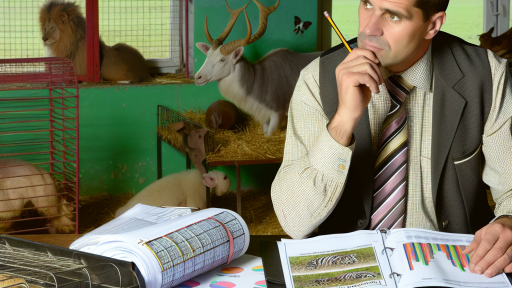Understanding the Basics of Aquaculture
Types of Aquaculture
Aquaculture has several types based on species and methods.
First, there is freshwater aquaculture.
This involves farming fish in freshwater environments.
Examples include tilapia and catfish farming.
Next, marine aquaculture focuses on sea species.
It involves farming fish like salmon and shrimp.
Moreover, there is brackish water aquaculture.
This typically combines both freshwater and saltwater species.
Species such as mullet thrive in brackish conditions.
Requirements for Successful Aquaculture
Success in aquaculture depends on various requirements.
Water quality is crucial for maintaining healthy stock.
Temperature, pH, and oxygen levels must be monitored regularly.
Feeding plays a vital role in the growth of farmed species.
High-quality feed ensures optimal health and growth rates.
Location is also a key factor to consider.
Transform Your Agribusiness
Unlock your farm's potential with expert advice tailored to your needs. Get actionable steps that drive real results.
Get StartedIt affects both water quality and accessibility to markets.
Choosing the Right Equipment
Selecting the appropriate equipment is essential for aquaculture success.
First, consider systems like recirculating aquaculture systems (RAS).
These systems help maintain water quality effectively.
Next, look into aeration devices.
These devices ensure adequate oxygen is supplied to fish.
Additionally, water filtration systems are vital.
They help remove waste and maintain clean water conditions.
Finally, monitoring equipment checks parameters continuously.
This enables timely interventions when conditions change.
Assessing Your Space
Determining Size of Your Aquaculture Setup
Begin by evaluating the overall area available for your aquaculture system.
Consider the dimensions and shape of the space to ensure optimal equipment placement.
Measure the potential length, width, and height carefully.
Next, calculate the total volume the equipment needs to occupy.
Your calculations should allow room for movement and future expansions.
Selecting the Ideal Location
Identify a location with easy access to water sources.
Good drainage is essential to protect your system from flooding.
Ensure the site has adequate sunlight for aquatic plants, if applicable.
Additionally, consider proximity to electrical outlets for your systems.
Lastly, maintain a safe distance from noise and pollution sources.
Analyzing Local Climate and Environment
Assess the climate conditions in your area before finalizing the setup.
Temperature fluctuations may affect your aquatic species’ health.
Local weather patterns can influence equipment maintenance and energy consumption.
Investigate how seasonal changes impact water quality and availability.
Showcase Your Farming Business
Publish your professional farming services profile on our blog for a one-time fee of $200 and reach a dedicated audience of farmers and agribusiness owners.
Publish Your ProfilePlanning for Future Expansion
Think about potential growth and changing needs of your aquaculture project.
Leave enough space for adding new tanks or filtration systems later.
Consider how future species diversification might affect your current setup.
By planning for expansion, you can avoid costly relocations down the road.
Water Quality Management: Choosing Filtration and Aeration Systems
Importance of Water Quality in Aquaculture
Water quality remains critical in any aquaculture setup.
It directly impacts fish health and growth rates.
Maintaining optimal conditions fosters a productive environment.
Regular testing helps track key water parameters.
Overview of Filtration Systems
Filtration systems play a vital role in water quality management.
They remove suspended solids and harmful substances from the water.
Choosing the right type of filter enhances system efficiency.
Consider mechanical, biological, and chemical filtration methods.
Mechanical Filtration
Mechanical filters physically remove particles from the water.
Common types include screen filters and sediment filters.
These filters need regular cleaning to maintain effectiveness.
Biological Filtration
Biological filters support beneficial bacteria growth.
These bacteria break down toxic ammonia and nitrite.
Using biofilters improves the nitrogen cycle in your system.
Chemical Filtration
Chemical filtration uses media to absorb harmful substances.
Activated carbon effectively removes toxins and odors.
Regularly replace chemical media for optimal performance.
Choosing Aeration Systems
Aeration systems enhance dissolved oxygen levels in water.
They are essential for fish respiration and overall health.
Multiple options exist, so select one that fits your needs.
Air Stones and Diffusers
Air stones create small bubbles that increase surface area.
This enhances oxygen transfer to the water.
Diffusers offer similar benefits with customizable flow rates.
Surface Agitation Devices
Surface agitation devices promote gas exchange at the water’s surface.
They help maintain oxygen levels while reducing carbon dioxide buildup.
Examples include surface aerators and fountain systems.
Maintaining Your Systems
Regular maintenance ensures efficient operation of filtration and aeration systems.
Schedule routine checks to clean or replace components.
Consistent monitoring helps prevent potential issues early.
Document performance metrics to track improvements over time.
Gain More Insights: Water Recirculation Systems for Efficient Fish Farming
Feeding Solutions
Selecting Automatic Feeders
Automatic feeders provide consistent feed distribution.
They minimize human labor, making them efficient.
These feeders offer precise portion control for fish.
They can be programmed to feed at regular intervals.
Furthermore, automatic feeders reduce waste by controlling feed amounts.
Showcase Your Farming Business
Publish your professional farming services profile on our blog for a one-time fee of $200 and reach a dedicated audience of farmers and agribusiness owners.
Publish Your ProfileChoosing a reliable automatic feeder is vital for success.
Some models include sensors for detecting fish activity.
This feature ensures feeding occurs only when necessary.
Considering Manual Feeding Methods
Manual feeding offers flexibility and control over the feeding process.
Farmers can observe fish behavior during feeding sessions.
Additionally, manual methods allow adjustments to feed types and amounts.
This can be advantageous in diverse aquaculture settings.
Despite higher labor involvement, manual feeding can be effective.
Familiarity with the fish’s needs helps enhance growth rates.
Moreover, this method helps build a stronger relationship with the stock.
Comparing the Two Approaches
Automatic feeders save time and effort in large operations.
Manual feeding can be ideal for smaller, more specialized setups.
Both methods come with a unique set of advantages.
Cost, time, and level of fish interaction are crucial factors.
Assessing these criteria will guide your decision-making process.
Ultimately, the best choice depends on your specific needs.
Learn More: Water Supply Solutions For Livestock Housing
Temperature Control: Equipment for Heating and Cooling Systems
Importance of Temperature Control
Temperature significantly impacts aquaculture production and fish health.
Maintaining optimal water temperatures is crucial for growth rates.
Moreover, it affects metabolism and reproductive cycles in aquatic species.
Types of Heating Systems
Electric heaters are common in aquaculture systems.
They provide precise temperature control, ensuring stability.
Another option is gas heaters, which can be efficient for larger systems.
Moreover, solar water heaters offer sustainable heating solutions.
Additionally, heat exchangers effectively utilize waste heat.
Types of Cooling Systems
Cooling systems are essential for managing high water temperatures.
Chillers are effective for large tanks or ponds.
They provide reliable temperature management during warm months.
Evaporative coolers are another cost-effective option.
They lower temperatures through water evaporation, reducing energy costs.
Control Systems and Automation
Automated control systems enhance temperature regulation.
They allow for real-time monitoring and adjustments.
Climate control systems ensure stability in variable weather conditions.
Integrating sensors can optimize heating and cooling efficiency.
Moreover, programmable thermostats save energy during off-peak hours.
Factors to Consider When Choosing Equipment
- Evaluate the specific temperature needs of the species.
- Consider the volume of water in your system.
- Assess the energy efficiency of the equipment.
- Review the initial investment and operating costs.
- Examine the reliability and lifespan of the equipment.
Ultimately, selecting the right heating and cooling equipment is crucial.
It directly influences the success of your aquaculture setup.
Gain More Insights: Innovative Technologies for Exotic Livestock Care

Monitoring Systems
Importance of Sensors
Sensors play a crucial role in aquaculture monitoring systems.
They provide real-time data about water quality.
Showcase Your Farming Business
Publish your professional farming services profile on our blog for a one-time fee of $200 and reach a dedicated audience of farmers and agribusiness owners.
Publish Your ProfileFor instance, sensors can measure temperature, pH, and salinity.
These measurements help maintain optimal conditions for aquatic life.
Moreover, timely data prevents the rise of harmful conditions.
Effective sensors also aid in early disease detection.
By monitoring water chemistry, you can protect your investments.
Automated Alerts
Automated alert systems are essential for efficient aquaculture management.
They notify operators of anomalies in water conditions instantly.
This immediate response capability enhances fish health.
Automated alerts reduce the risk of mass die-offs in fish populations.
Furthermore, these systems streamline operations and reduce labor costs.
Both manual and automated checks ensure a balanced ecosystem.
Regular updates from these systems aid in informed decision-making.
Integration with Management Systems
Integrating monitoring systems with management software enhances overall efficiency.
This integration provides a comprehensive view of aquaculture operations.
Users can track growth rates, feed conversion, and health metrics simultaneously.
Data visualization tools enable better analysis of trends over time.
Ultimately, this leads to more informed and proactive management decisions.
Incorporating advanced technology like AI improves predictions and outcomes.
This approach allows for a more sustainable aquaculture practice.
Uncover the Details: Effective Pasture Management for Sheep
Cost Analysis: Budgeting for Different Equipment Options
Understanding Your Budget
Effective budgeting is crucial for aquaculture success.
You need to assess your financial resources carefully.
Consider both your initial investments and ongoing operational costs.
This will help you make informed purchasing decisions.
Types of Equipment and Their Costs
Equipment costs can vary significantly based on type and specifications.
Choose from essential items like tanks, filters, and aerators.
For instance, fish tanks can range from a few hundred to thousands of dollars.
Similarly, filtration systems may also differ in price depending on capacity and technology.
Calculating Total Investment
When budgeting, factor in installation costs for your equipment.
Don’t forget the expenses associated with maintenance and repairs.
Also, account for potential future upgrades to your system.
This comprehensive view will prevent unforeseen financial issues.
Consider Used Equipment
Buying used equipment can be a cost-effective option.
Check reputable sources to find quality used gear.
However, inspect the items thoroughly before purchase.
Ensure they meet your quality standards and operational needs.
Understanding Financing Options
If you face budget constraints, consider financing options.
Many lenders offer loans specifically for aquaculture projects.
Look for favorable interest rates and payment terms.
Additionally, explore grants and subsidies available for aquaculture.
Showcase Your Farming Business
Publish your professional farming services profile on our blog for a one-time fee of $200 and reach a dedicated audience of farmers and agribusiness owners.
Publish Your ProfileBalancing Cost and Quality
It’s important to balance cost with quality when selecting equipment.
Opt for reliable brands known for durability and efficiency.
Investing in quality equipment may save money in the long run.
Evaluate warranty and customer support options to enhance your investment.
Maintenance and Upkeep: Choosing Durable and Serviceable Equipment
Importance of Durability
Durability is a critical factor in selecting aquaculture equipment.
High-quality equipment withstands harsh aquatic environments.
Additionally, durable items lead to lower long-term costs.
Investing in robust equipment minimizes the need for frequent replacements.
Key Features of Serviceable Equipment
Serviceable equipment simplifies maintenance tasks.
Look for features that facilitate easy cleaning and repair.
Furthermore, consider equipment with accessible components.
This approach ensures quick service and minimal downtime.
Material Considerations
The materials used in construction significantly affect durability.
Choose equipment made from corrosion-resistant materials.
Stainless steel and high-density polyethylene are excellent options.
These materials will endure exposure to water and chemicals.
Brand Reputation and Reliability
Research reputable brands known for reliable equipment.
Established companies often provide warranties and support services.
Check customer reviews for insights into performance and longevity.
Additionally, consider brands that offer comprehensive product training.
Regular Maintenance Practices
Implement a routine maintenance schedule for your equipment.
This practice enhances performance and lifespan.
Inspect equipment regularly for wear and tear.
Stay attentive to signs of rust, damage, or inefficiency.
Supplier Support and Service
Choose suppliers that offer robust customer support.
Reliable support enhances your equipment’s longevity.
Inquire about after-sale services and spare part availability.
This ensures you can address issues promptly and effectively.
Additional Resources
Lessons in raising a colony of meat rabbits. Aka everything you’ve …
Laws and Regulations that Apply to Your Agricultural Operation by …




